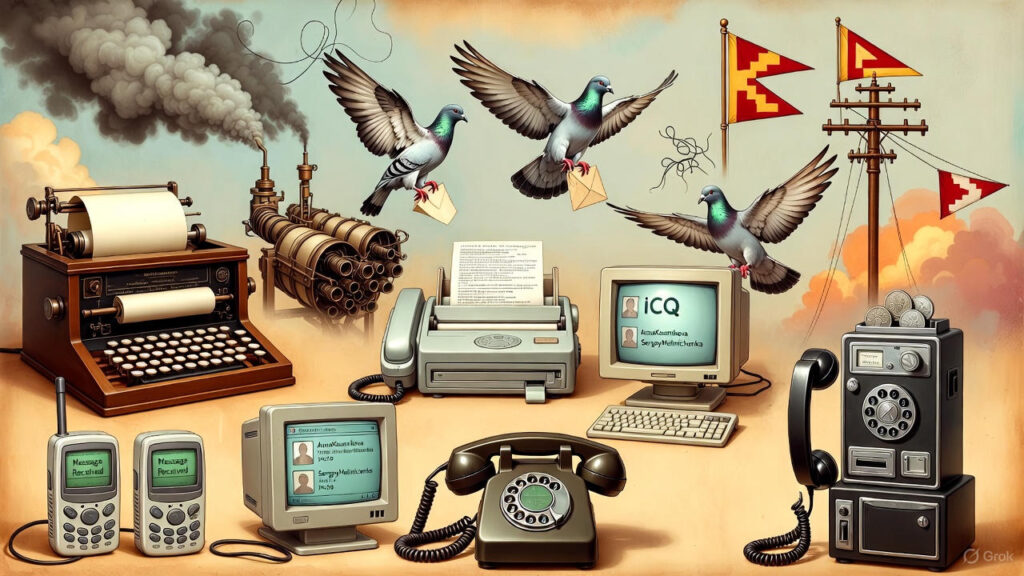In an era where we send voice messages via Telegram, video call on Zoom, and share memes on TikTok, it’s easy to forget how people connected just a couple of decades ago. The history of communication is a chain of ingenious inventions, many of which have faded into oblivion, supplanted by digital giants. Today, we dive into the world of obsolete and vanished means of communication.
Smoke Signals and Drums
Imagine: you’re atop a hill, lighting a fire and sending puffs of smoke skyward. This isn’t a shaman’s ritual—it’s one of the oldest forms of communication! Native Americans in North America, African tribes, and even ancient Chinese used smoke signals. The system was simple: a specific number of puffs meant “enemy approaching,” “hunt successful,” or “gather for council.”
In Africa, “talking drums” transmitted complex messages over dozens of kilometers. Drummers encoded words with rhythms and tones—like Morse code with an African flair. Why did they vanish? Fire and drums required line of sight or hearing, favorable weather, and skill. The telegraph’s invention in the 19th century rendered them obsolete. Yet, in the Amazon jungles, drums still echo occasionally—a remnant of the past!
Carrier Pigeons
Pigeons aren’t just park birds; they were elite couriers of antiquity. As far back as Ancient Egypt and Persia, they carried messages. The bird homed in using Earth’s magnetic field, with a note tied to its leg. In the Middle Ages, pigeon post was standard: Ottoman sultans received provincial news in hours.
Peak fame came during World War I. A pigeon named Cher Ami saved a U.S. battalion by delivering a message through gunfire, losing a leg and an eye. It was awarded a medal!
Why did they fade? Telegraph, telephone, then aviation. The last “combat” pigeon was retired in the 1950s. Today, pigeon post is a hobby for enthusiasts or a tourist attraction in Iran.
Semaphore and Optical Telegraph: Flags and Towers
In the 1790s, Frenchman Claude Chappe invented the optical telegraph—a chain of towers with movable arms. Operators signaled letters via positions. From Paris to Lyon—200 km—a message took minutes! Napoleon used it for army orders.
Similar lines appeared in Britain and Russia. Flag semaphore was the naval version: sailors waved flags in code.
Disappearance: Morse’s electric telegraph in 1837. Towers were demolished; flags relegated to museums.
Telegraph
Samuel Morse sent the first telegram in 1844: “What hath God wrought!” The telegraph linked continents: the 1866 transatlantic cable connected Europe and America.
Telegrams were concise—charged per word. “STOP” replaced periods to save money. In Russia, telegraph arrived in the 1830s, linking St. Petersburg and Moscow.
Decline: Bell’s telephone in 1876. India’s last telegram was in 2013! Western Union shut down in the U.S. in 2006.
Pneumatic Mail
In the 19th century, Paris, London, and New York built underground tube networks. Capsules with letters were “shot” via compressed air—up to 10 km/h! Prague’s post office used it until 2002.
It vanished due to fax and email.
Fax
Invented in 1843, but boomed in the 1980s. Fax scanned documents and sent them over phone lines. In Japan, it was a business icon.
Peak: 1990s, millions of machines. Decline: email and scanners in the 2000s. Office faxes are now rarities. In Japan, they persist due to kanji—easier to send handwriting.
Pagers
In the 1950s for doctors; by the 1990s, for everyone. One-way: a number or short message. In Russia, “pagers” symbolized the 2000s.
Codes: 07734 meant “hello” upside down. They disappeared with SMS in the 2000s. Japan shut down in 2019.
These means didn’t vanish without reason: speed, convenience, scale.

